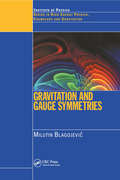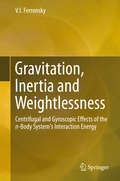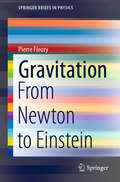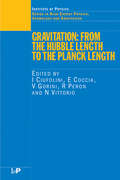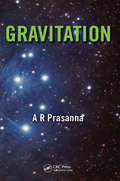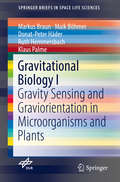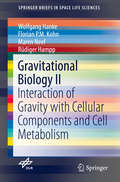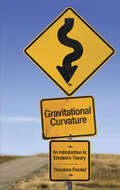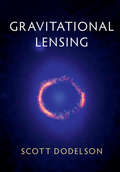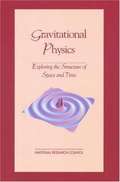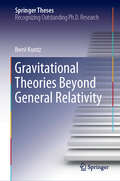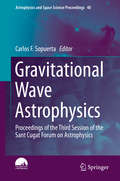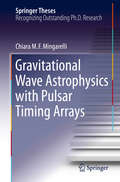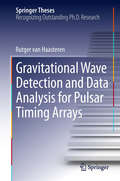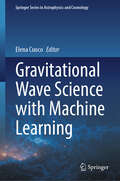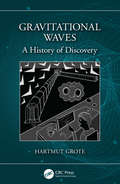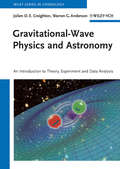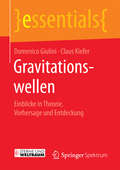- Table View
- List View
Gravitation and Gauge Symmetries (Series In High Energy Physics, Cosmology And Gravitation Ser.)
by M BlagojevicIn the course of the development of electromagnetic, weak and strong interactions, the concept of (internal) gauge invariance grew up and established itself as an unavoidable dynamical principle in particle physics. It is less known that the principle of equivalence, and the basic dynamical properties of the gravitational interaction can also be ex
Gravitation and Spacetime
by Remo Ruffini Hans C. OhanianThe third edition of this classic textbook is a quantitative introduction for advanced undergraduates and graduate students. It gently guides students from Newton's gravitational theory to special relativity, and then to the relativistic theory of gravitation. General relativity is approached from several perspectives: as a theory constructed by analogy with Maxwell's electrodynamics, as a relativistic generalization of Newton's theory, and as a theory of curved spacetime. The authors provide a concise overview of the important concepts and formulas, coupled with the experimental results underpinning the latest research in the field. Numerous exercises in Newtonian gravitational theory and Maxwell's equations help students master essential concepts for advanced work in general relativity, while detailed spacetime diagrams encourage them to think in terms of four-dimensional geometry. Featuring comprehensive reviews of recent experimental and observational data, the text concludes with chapters on cosmology and the physics of the Big Bang and inflation.
Gravitation, Inertia and Weightlessness
by V. I. FerronskyThis work discusses the problem of physical meaning of the three main dynamical properties of matter motion, namely gravitation, inertia and weightlessness. It considers that Newtonian gravitation and Galileo's inertia are the centrifugal effects of interaction energy of a self-gravitating n-body system and its potential field. A self-gravitating celestial body appears to be an excellent natural centrifuge that is rotated by the energy of interacting elementary particles. Weightlessness is a consequence of the centrifugal effect of elementary particles interaction that appears at differentiation of a body matter with respect to density. The author analyzes the problem of creation of mass particles and elements from the elementary particles of "dark matter", and discusses the basic physics of the Jacobi dynamics from the viewpoint of quantum gravitation. Chapters assert that the fundamentals of Jacobi dynamics completely correspond to conditions of natural centrifuges. The centrifuge is an excellent experimental model for the study of dynamical effects in solving the many body problem. In this book, readers may follow the demonstration of some of those studies and follow derivations, solutions and conclusions that provide a solid basis for further research in celestial mechanics, geophysics, astrophysics, geo- and planetary sciences.
Gravitation: From Newton to Einstein (SpringerBriefs in Physics)
by Pierre FleuryThis primer proposes a journey from Newton's dynamics to Einstein's relativity. It constitutes a pedagogical, rigorous, and self-contained introduction to the concepts and mathematical formulation of gravitational physics.In particular, much attention is devoted to exploring and applying the basic tools of differential geometry, that is the language of general relativity. Real-world manifestations of relativity, such as time dilation, gravitational waves, and black holes, are also discussed in detail.This book is designed for third-year bachelor or first-year master students in theoretical physics, who are already familiar with Newton's physics, possibly had an introductory course on special relativity, and who are seeking to learn general relativity on a firm basis.
Gravitation: From the Hubble Length to the Planck Length (Series in High Energy Physics, Cosmology and Gravitation)
by Ugo Moschella Vittorio Gorini Ignazio Ciufolini Pietro FréAlthough gravity is the dominant force of nature at large distances (from intermediate scales to the Hubble length), it is the weakest of forces in particle physics, though it is believed to become important again at very short scales (the Planck length). The conditions created in particle accelerators are similar to those at the time of the early
Gravitation: Proceedings Of The 15th Iagrg Conference, N. Bengal University, Nov. 4-7, 1989
by A R PrasannaThis book suitable for post graduates in Physics and Astrophysics aims at introducing the theory of general relativity as an important background for doing astrophysics. Starting from a detailed discussion of the various mathematical concepts for doing general relativity, the book introduces the geometric description of gravity. It gives a brief historical perspective to classical mechanics and electrodynamics making an attempt to establish the necessity of special relativity as propounded by Einstein extending to General Relativity. This book is a good starting point for post graduates wanting to pursue the modern topics of Cosmology, High energy astrophysics and related areas.
Gravitational Biology I: Gravity Sensing and Graviorientation in Microorganisms and Plants (SpringerBriefs in Space Life Sciences)
by Markus Braun Maik Böhmer Donat-Peter Häder Ruth Hemmersbach Klaus PalmeThis book summarizes what is currently known about gravity sensing and response mechanisms in microorganisms, fungi, lower and higher plants; starting from the historical eye-opening experiments from the 19th century up to today’s extremely rapid advancing cellular, molecular and biotechnological research. All forms of life are constantly exposed to gravity and it can be assumed that almost all organisms have developed sensors and respond in one way or the other to the unidirectional acceleration force,this books shows us some of these different ways.The book is written for plant biologists and microbiologists as well as scientists interested in space and gravitational biology.
Gravitational Biology II (Springer Briefs in Space Life Sciences )
by Wolfgang Hanke Florian P. M. Kohn Maren Neef Rüdiger HamppThis volume of the series Space Life Sciences provides insights into the latest findings of gravity research and the effect of gravity on biological systems, specifically on a cellular and molecular level. It starts by explaining the underlying physics of gravity and presenting some novel ideas on the basic principles of gravity perception. It then goes on to discuss how, in response to gravity perception, secondary messengers such as calcium and hydrogen peroxide, might control responses further downstream, like gene and protein expression and modulation. Further, it describes the consequences for animal and plant cells as well as for metabolism. Written by experts in the field, this book is a valuable resource for students and researchers in biochemistry, medicine and biomedicine, wanting to gain a solid understanding of membrane biology, secondary messenger function and gene and protein expression, specifically in the context of gravity.
Gravitational Curvature: An Introduction to Einstein's Theory (Dover Books on Physics)
by Prof. Theodore FrankelThis classic text and reference monograph applies modern differential geometry to general relativity. A brief mathematical introduction to gravitational curvature, it emphasizes the subject's geometric essence and stresses the global aspects of cosmology. Suitable for independent study as well as for courses in differential geometry, relativity, and cosmology. 1979 edition.
Gravitational Few-Body Dynamics: A Numerical Approach
by Seppo MikkolaUsing numerical integration, it is possible to predict the individual motions of a group of a few celestial objects interacting with each other gravitationally. In this introduction to the few-body problem, a key figure in developing more efficient methods over the past few decades summarizes and explains them, covering both basic analytical formulations and numerical methods. The mathematics required for celestial mechanics and stellar dynamics is explained, starting with two-body motion and progressing through classical methods for planetary system dynamics. This first part of the book can be used as a short course on celestial mechanics. The second part develops the contemporary methods for which the author is renowned - symplectic integration and various methods of regularization. This volume explains the methodology of the subject for graduate students and researchers in celestial mechanics and astronomical dynamics with an interest in few-body dynamics and the regularization of the equations of motion.
Gravitational Lensing
by Scott DodelsonGravitational lensing is a consequence of general relativity, where the gravitational force due to a massive object bends the paths of light originating from distant objects lying behind it. Using very little general relativity and no higher level mathematics, this text presents the basics of gravitational lensing, focusing on the equations needed to understand the phenomena. It then applies them to a diverse set of topics, including multiply imaged objects, time delays, extrasolar planets, microlensing, cluster masses, galaxy shape measurements, cosmic shear, and lensing of the cosmic microwave background. This approach allows undergraduate students and others to get quickly up to speed on the basics and the important issues. The text will be especially relevant as large surveys such as LSST and Euclid begin to dominate the astronomical landscape. Designed for a one semester course, it is accessible to anyone with two years of undergraduate physics background.
Gravitational Physics: Exploring the Structure of Space and Time
by Committee on Gravitational PhysicsGravitational Physics assesses the achievements of the field over the past decade in both theory and experiment, identifies the most promising opportunities for research in the next decade, and describes the resources necessary to realize those opportunities. A major theme running through the opportunities is the exploration of strong gravitational fields, such as those associated with black holes.The book, part of the ongoing decadal survey Physics in a New Era, examines topics such as gravitational waves and their detection, classical and quantum theory of strong gravitational fields, precision measurements, and astronomical observations relevant to the predictions of Einstein's theory of general relativity.
Gravitational Theories Beyond General Relativity (Springer Theses)
by Iberê KuntzDespite the success of general relativity in explaining classical gravitational phenomena, several problems at the interface between gravitation and high energy physics still remain open. The purpose of this thesis is to explore quantum gravity and its phenomenological consequences for dark matter, gravitational waves and inflation. A new formalism to classify gravitational theories based on their degrees of freedom is introduced and, in light of this classification, it is argued that dark matter is no different from modified gravity. Gravitational waves are shown to be damped due to quantum degrees of freedom. The consequences for gravitational wave events are also discussed. The non-minimal coupling of the Higgs boson to gravity is studied in connection with Starobinsky inflation and its implications for the vacuum instability problem is analyzed.
Gravitational Wave Astrophysics
by Carlos F. SopuertaThis book offers review chapters written by invited speakers of the 3rd Session of the Sant Cugat Forum on Astrophysics - Gravitational Waves Astrophysics. All chapters have been peer reviewed. The book goes beyond normal conference proceedings in that it provides a wide panorama of the astrophysics of gravitational waves and serves as a reference work for researchers in the field.
Gravitational Wave Astrophysics with Pulsar Timing Arrays
by Chiara M. F. MingarelliThis Ph. D. thesis from the University of Birmingham UK opens new research avenues in the use of Pulsar Timing Arrays (PTAs) to study populations of super-massive black hole binaries through gravitational-wave observations. Chiara Mingarelli's work has shown for the first time that PTAs can yield information about the non-linear dynamics of the gravitational field. This is possible because PTAs capture, at the same time, radiation from the same source emitted at stages of its binary evolution that are separated by thousands of years. Dr. Mingarelli, who is the recipient of a Marie Curie International Outgoing Fellowship, has also been amongst the pioneers of the technique that will allow us to probe the level of anisotropy of the diffuse gravitational-wave background radiation from the whole population of super-massive black hole binaries in the Universe. Indeed, future observations will provide us with hints about the distribution of galaxies harboring massive black holes and insights into end products of hierarchical mergers of galaxies.
Gravitational Wave Detection and Data Analysis for Pulsar Timing Arrays
by Rutger HaasterenPulsar timing is a promising method for detecting gravitational waves in the nano-Hertz band. In his prize winning Ph. D. thesis Rutger van Haasteren deals with how one takes thousands of seemingly random timing residuals which are measured by pulsar observers, and extracts information about the presence and character of the gravitational waves in the nano-Hertz band that are washing over our Galaxy. The author presents a sophisticated mathematical algorithm that deals with this issue. His algorithm is probably the most well-developed of those that are currently in use in the Pulsar Timing Array community. In chapter 3, the gravitational-wave memory effect is described. This is one of the first descriptions of this interesting effect in relation with pulsar timing, which may become observable in future Pulsar Timing Array projects. The last part of the work is dedicated to an effort to combine the European pulsar timing data sets in order to search for gravitational waves. This study has placed the most stringent limit to date on the intensity of gravitational waves that are produced by pairs of supermassive black holes dancing around each other in distant galaxies, as well as those that may be produced by vibrating cosmic strings. Rutger van Haasteren has won the 2011 GWIC Thesis Prize of the Gravitational Wave International Community for his innovative work in various directions of the search for gravitational waves by pulsar timing. The work is presented in this Ph. D. thesis.
Gravitational Wave Science with Machine Learning (Springer Series in Astrophysics and Cosmology)
by Elena CuocoThis book highlights the state of the art of machine learning applied to the science of gravitational waves. The main topics of the book range from the search for astrophysical gravitational wave signals to noise suppression techniques and control systems using machine learning-based algorithms. During the four years of work in the COST Action CA17137-A network for Gravitational Waves, Geophysics and Machine Learning (G2net), the collaboration produced several original publications as well as tutorials and lectures in the training schools we organized. The book encapsulates the immense amount of finding and achievements. It is a timely reference for young researchers approaching the analysis of data from gravitational wave experiments, with alternative approaches based on the use of artificial intelligence techniques.
Gravitational Waves
by Ugo Moschella Vittorio Gorini Ignazio Ciufolini Pietro FréGravitational waves (GWs) are a hot topic and promise to play a central role in astrophysics, cosmology, and theoretical physics. Technological developments have led us to the brink of their direct observation, which could become a reality in the coming years. The direct observation of GWs will open an entirely new field: GW astronomy. This is expe
Gravitational Waves from a Quantum Field Theory Perspective (Lecture Notes in Physics #1013)
by Subhendra MohantyThis book treats the subject of gravitational waves (GWs) production in binary stars or black-holes and in the early universe, using tools of quantum field theory which are familiar to graduate students and researchers in particle physics. A special focus is given to the generation of templates of gravitational wave signals from Feynman diagram calculations of transition amplitudes, which interests active researchers in GWs. The book presents field theory concepts, like supersymmetry realized in spinning binaries and soft-graviton theorems, that can have practical applications in novel GW signals, like the memory effect. The book also aims at specialists in both GWs and particle physics addressing cosmological models of phase transition and inflation that can be tested in observations at terrestrial and space based interferometers, pulsar timing arrays, and the cosmic microwave anisotropy observations.
Gravitational Waves: A History of Discovery
by Hartmut GroteThe historic detection of gravitational waves on September 14, 2015, prompted by the highly energetic fusion of two black holes, has made events in the universe "audible" for the first time. This expansion of the scientific sensorium has opened a new chapter in astronomy and already led to, among others, fascinating new insights about the abundance of black holes, the collision of neutron stars, and the origin of heavy chemical elements. The history of this event, which is epochal for physics, is reconstructed in this book, along with a walk-through of the main principles of how the detectors operate and a discussion of how the search for gravitational waves is conducted. The book concludes with an update of the latest detections and developments to date and a brief look into the future of this exciting research field. This book is accessible to non-specialist readers from a general audience and is also an excellent introduction to the topic for undergraduates in physics. Features: Provides an introduction to the historic discovery of gravitational waves Explains the inner workings of the detectors and the search to find the waves hidden in the data Authored by a renowned specialist involved in the ground-breaking discovery Hartmut Grote is a Professor of physics at Cardiff University, UK. His main expertise is in experimental gravitational-wave physics, and he has worked on building and improving gravitational wave detectors for over 20 years. From 2009 to 2017, he was the scientific leader of the British-German gravitational-wave detector: GEO600.
Gravitational Waves: A New Window to the Universe
by Ajit Kembhavi Pushpa KhareGravitational waves were first predicted by Albert Einstein in 1916, a year after the development of his new theory of gravitation known as the general theory of relativity. This theory established gravitation as the curvature of space-time produced by matter and energy. To be discernible even to the most sensitive instruments on Earth, the waves have to be produced by immensely massive objects like black holes and neutron stars which are rotating around each other, or in the extreme situations which prevail in the very early ages of the Universe. This book presents the story of the prediction of gravitational waves by Albert Einstein, the early attempts to detect the waves, the development of the LIGO detector, the first detection in 2016, the subsequent detections and their implications. All concepts are described in some detail, without the use of any mathematics and advanced physics which are needed for a full understanding of the subject. The book also contains description of electromagnetism, Einstein’s special theory and general theory of relativity, white dwarfs, neutron stars and black holes and other concepts which are needed for understanding gravitational waves and their effects. Also described are the LIGO detectors and the cutting edge technology that goes into building them, and the extremely accurate measurements that are needed to detect gravitational waves. The book covers these ideas in a simple and lucid fashion which should be accessible to all interested readers. The first detection of gravitational waves was given a lot of space in the print and electronic media. So, the curiosity of the non-technical audience has been aroused about what gravitational waves really are and why they are so important. This book seeks to answer such questions.
Gravitational-Wave Physics and Astronomy: An Introduction to Theory, Experiment and Data Analysis (Wiley Series In Cosmology Ser. #1)
by Jolien D. Creighton Warren G. AndersonThis most up-to-date, one-stop reference combines coverage of both theory and observational techniques, with introductory sections to bring all readers up to the same level. Written by outstanding researchers directly involved with the scientific program of the Laser Interferometer Gravitational-Wave Observatory (LIGO), the book begins with a brief review of general relativity before going on to describe the physics of gravitational waves and the astrophysical sources of gravitational radiation. Further sections cover gravitational wave detectors, data analysis, and the outlook of gravitational wave astronomy and astrophysics.
Gravitationswellen: Einblicke in Theorie, Vorhersage und Entdeckung (essentials)
by Domenico Giulini Claus Kiefer100 Jahre nach Einsteins Arbeit zur Relativit#65533;tstheorie ist der Beweis f#65533;r die Existenz von Gravitationswellen eine Sensation. Die angesehenen Wissenschaftler Domenico Giulini und Claus Kiefer geben in diesem essential einen kompakten #65533;berblick #65533;ber dieses Ph#65533;nomen der theoretischen Physik und #65533;ber die indirekten und die k#65533;rzlich gelungenen direkten Nachweise von Gravitationswellen. Vorhergesagt durch die Allgemeine Relativit#65533;tstheorie, entstehen sie in hochenergetischen astrophysikalischen Prozessen und liefern wertvolle Informationen #65533;ber Supernovae und die Kollision schwarzer L#65533;cher. Ausgehend von der ersten Detektion besitzt die Menschheit mit diesen Erkenntnissen ,,ein neues Fenster" ins Universum, dass die Forschung noch lange besch#65533;ftigen wird.
Gravity
by Eric PoissonThis textbook explores approximate solutions to general relativity and their consequences. It offers a unique presentation of Einstein's theory by developing powerful methods that can be applied to astrophysical systems. Beginning with a uniquely thorough treatment of Newtonian gravity, the book develops post-Newtonian and post-Minkowskian approximation methods to obtain weak-field solutions to the Einstein field equations. The book explores the motion of self-gravitating bodies, the physics of gravitational waves, and the impact of radiative losses on gravitating systems. It concludes with a brief overview of alternative theories of gravity. Ideal for graduate courses on general relativity and relativistic astrophysics, the book examines real-life applications, such as planetary motion around the Sun, the timing of binary pulsars, and gravitational waves emitted by binary black holes. Text boxes explore related topics and provide historical context, and over 100 exercises present challenging tests of the material covered in the main text.
Gravity
by George GamowA distinguished physicist and teacher, George Gamow also possessed a special gift for making the intricacies of science accessible to a wide audience. In Gravity, he takes an enlightening look at three of the towering figures of science who unlocked many of the mysteries behind the laws of physics: Galileo, the first to take a close look at the process of free and restricted fall; Newton, originator of the concept of gravity as a universal force; and Einstein, who proposed that gravity is no more than the curvature of the four-dimensional space-time continuum.Graced with the author's own drawings, both technical and fanciful, this remarkably reader-friendly book focuses particularly on Newton, who developed the mathematical system known today as the differential and integral calculus. Readers averse to equations can skip the discussion of the elementary principles of calculus and still achieve a highly satisfactory grasp of a fascinating subject.Starting with a chapter on Galileo's pioneering work, this volume devotes six chapters to Newton's ideas and other subsequent developments and one chapter to Einstein, with a concluding chapter on post-Einsteinian speculations concerning the relationship between gravity and other physical phenomena, such as electromagnetic fields.
